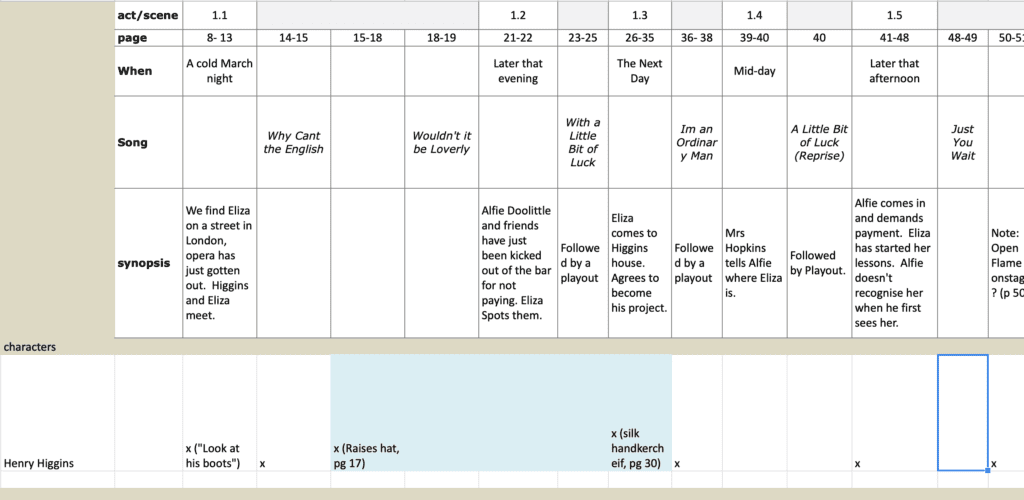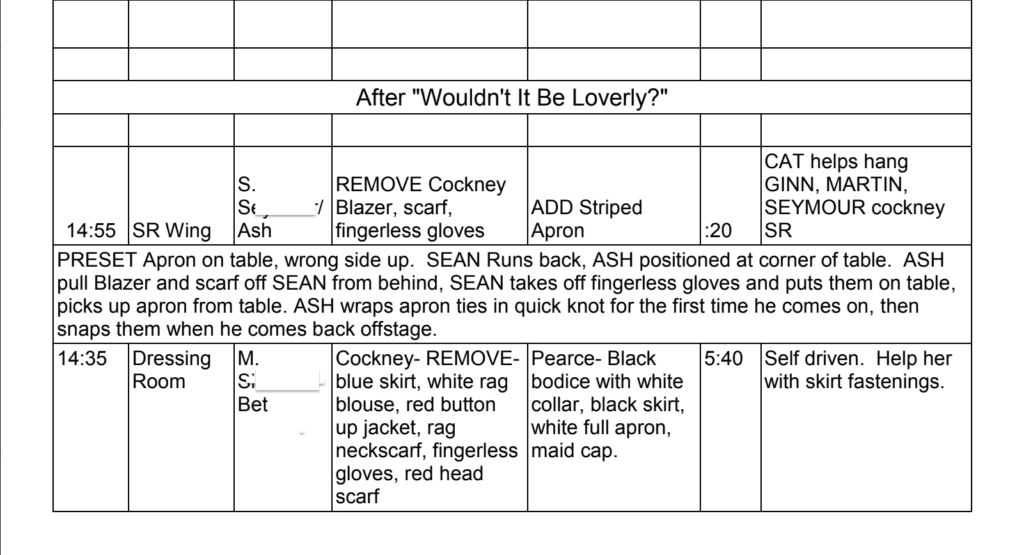Below is a list of 5 documents I always have on my clipboard on the first day of tech. While working in regional theatre, more often than not, the wardrobe department is tasked with taking on a huge show. All the while, there might not be as many dressers as one might expect on Broadway. You also might not have as much tech time as one would hope (speaking from experience having more than one first preview without actually having teched the whole show).
In a regional theatre setting, these documents help you understand your show quicker, flag problem areas before they come up in tech, as well as help answer any questions the actors or crew members might have before they have them. In tech, you never know how much downtime may or may not exist, so it’s crucial to be ready for anything.

Click on any of the terms below to learn more in-depth about the specific paperwork listed here and to see examples! (Coming Soon)
1) Actor/Scene Breakdown
While working on a show as the Wardrobe Supervisor, I will typically make my own version of an actor-scene breakdown. If the designer has also made a plot, I will also have theirs out while I am working through my own. In my breakdown, I am noting any costume pieces that are noted in the show (“If a stage direction states that she takes a coat off the coat rack, I want to know how the coat is going to get there–will I be presetting it at top of the show? If there is a candy stuck in a pocket, will I want to line the pocket with something for laundry purposes?). I am also noting the different characters people are playing and how many scenes/songs they have between costume changes (according to the script).
Also, I pay attention to the show’s basic structure, such as when musical numbers are happening. While building my plot, I might also color code changes– my favorite being a blue highlight for a change that’s happening that will probably be 5+ minutes long, and red for a change that will be Quick. You might need to note any technical aspect of the show on the plot, such as open flame onstage.

This information gives me an idea of which actors might need a lot of costume help. It also aids conversations with the designer and shop manager.
2) Entrances/ Exits Plot
Typically, you should be able to ask Stage Management for a copy of their entrances and exits plot. Sometimes, however, you will have to make your own. This document will tell you the exact times from Top Of Show that anyone is entering/ exiting the stage, and what side of the stage they are entering/ exiting from. Even if someone else does give you theirs, it’s essential to double-check these times at the designer run. Sometimes, the times on the SM paperwork can be a couple of weeks old, and times could have really tightened up in that period.
After creating this document, it can be used to figure out how long everyone has for any of their changes. This information typically comes in handy during tech when actors or dressers might be anxious about an upcoming change. It will help you tell them definitively that they had 6.5 minutes offstage for the change during the designer run.

An Entrance/ Exit Plot is also helpful to make an outline of where backstage your changes are happening. If a change is under 30 seconds, you might need to talk to SM about having space backstage for wardrobe.
3) Piece List
Typically, you should also receive this from your designer as well. It should be broken down into actor, then further into the scene or look. I will typically walk through the racks with the designer right before tech to talk through the pieces. This helps everyone get on the same page (is it a “teal tie”…or is that green with blue paisley?). Talking through the rack also gives you the opportunity to write in any last-minute additions. It’s not uncommon to have to update accessories or other pieces added in fittings.
If your designer does not give you a piece list, you will probably still want to make actor piece lists to the best of your abilities. It’s a good idea to do it before everything gets picked up and moved into the dressing rooms, just so you have time to lay eyes on everything before pieces possibly get misplaced in the craziness of tech.
4) Headshot Cheat Sheet
This is another document that you will probably receive from Stagr Management. It’s a great idea to always have a headshot cheat sheet on your phone or clipboard for tech. There are so many things happening to remember every introduction that is being made– especially with a cast of 30. (God forbid there are two “Ryans” in the cast that you need to remember). And even if you don’t need it, someone around you surely will.
5) Run Sheet: Version 1
The first 4 documents listed have all the information you need for your 5th document, a working “tech run sheet”. In this document, I’ll typically include every known change and its key information. This might include the actor being changed, the dresser Im assigning to the change, the pieces that are traveling to and from the change, how fast the changes are, and then leaving a place for dresser notes.
I make this document for all the dressers to have, and then write any notes they might have. (i.e. bring a water bottle to this change, or helping a dresser to hang things up!) I update this document for the first preview after talking through the show with the dressers, and then again for opening.

Wardrobe Supervising is so much about paperwork and organization, even in Regional Theatre. What are your must-have documents for a successful tech process? Let us know in the comments!






